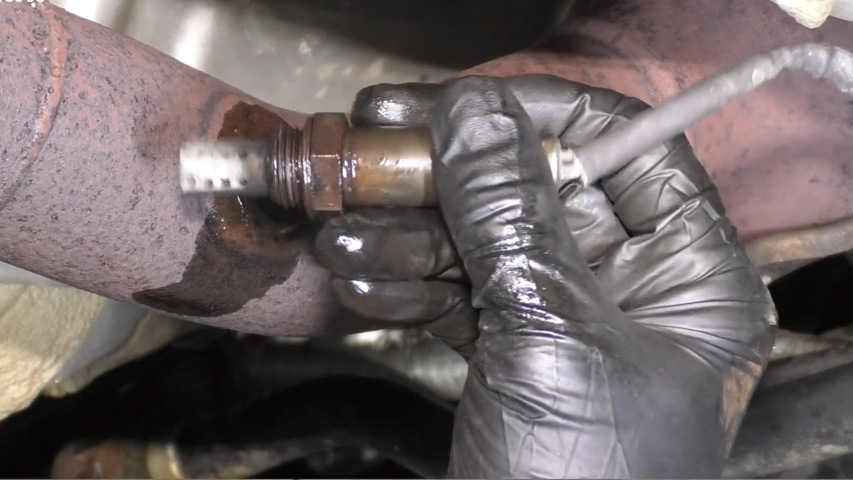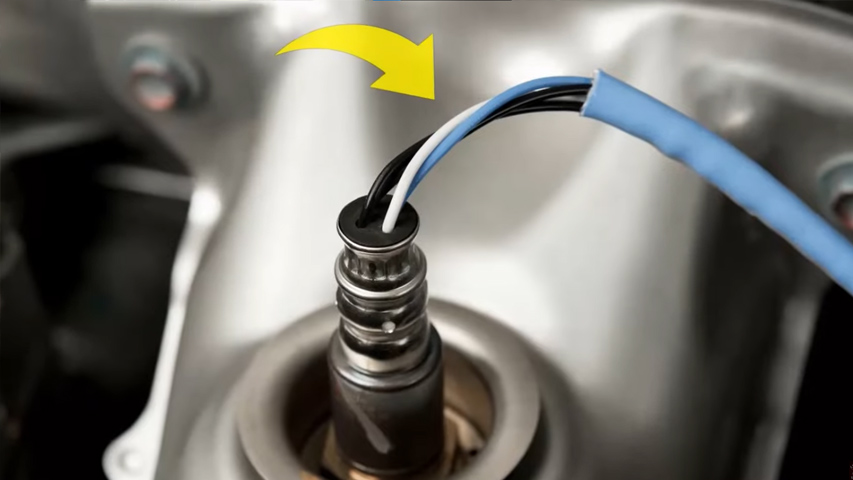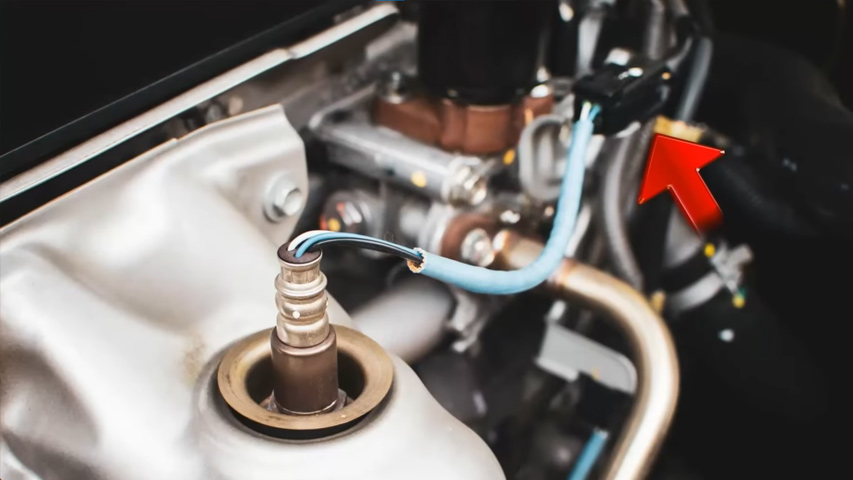
Bad O2 Sensor Symptoms
O2 sensor failure in the car can have several signs. The following are some of the signs:
- Check engine light turns on.
- Fuel consumption is up.
- The car is rapping.
- Dark-colored smoke comes out of the exhaust with high concentration and foul odor.
- The engine has unusual noise.
- The catalyst is damaged by overheating of the engine size.
- Increased engine speed in position
- Not biting the car
All this indicates that the car sensor is broken. The following is a description of the following:
THE CHECK ENGINE light is ON.

If the check engine light goes on, it’s the first and most serious sign that any car sensor, like an oxygen sensor, breaks down. So when the check light comes on, you can’t say for sure that the oxygen sensor must be broken. At this time it is necessary to find out the cause of the problem by digging. The wrong codes sent from the car’s computer to the Digg device indicate whether the oxygen sensor has a problem.
Increased Fuel Consumption
So much fuel consumption of the car has increased, it means that the oxygen sensor is broken. So if the fuel consumption suddenly increases, you have to make sure that the oxygen sensor is broken. The failure of this sensor prevents the ratio of air and fuel in the fuel chamber from adjusting properly. So there’s a lot of fuel coming into the engine. This causes the fuel consumption to increase significantly.
Car rapping
If the air-fuel ratio fails, it reduces the combustion efficiency of the engine. Due to this, the normal and standard power of the engine is reduced. Sometimes this problem occurs by rapping the car during movement. In other words, the engine of the car runs irregularly.
Black, thick smoke coming out of the exhaust with a bad smell
Excessive fuel entering the engine due to the failure of the oxygen sensor causes a lot of gasoline to burn in the fuel compartment. In this situation, it seems normal to increase the volume of contaminants in the engine. This manifests itself as black smoke from the engine.
Another defect that occurs in the engine is incomplete combustion. In this situation, the gasoline fuel loan is not completely carried out in the combustion chamber. So besides carbon dioxide, other polluting gases like sulfur dioxide are also produced. These contaminants typically manifest themselves with a foul odor that resembles the smell of rotten eggs. If you are in the rear of the car and in the vicinity of the exhaust, you will notice this bad smell.

Unusual Sounds from the Engine
All signs of Oxygen Sensor failure due to a proper combination of air and fuel in the engine. Sometimes the amount of fuel entering the engine may decrease compared to air. So the engine is faced with a combination of thin air and fuel. This, in addition to reducing engine power, causes noise similar to the impact from the engine side.
You should also know that it is possible to combine more fuel with air than normal and standard. In this situation, a combination with a very high concentration is introduced into the engine. The fuel entering the engine in large quantities makes it sound like a ding dong.
You should know that loosening the connections in the oxygen sensor, although it cannot be a breakdown of this part, will still cause problems. One of these flaws is a sound similar to a knock that can be heard from the engine.
Catalyst damage due to overheating of the Engine
The oxygen exhaust sensor is on its way out of pollutants on the exhaust side. In fact, this Section measures the amount of oxygen that is present in the pollutants coming out of the engine. Another important component in the way pollutants come out is the catalyst. A section that in normal condition has a life of approximately 80-100 thousand kilometers. The catalyst’s role is to reduce the amount of harmful and dangerous pollutants that come out of the car’s engine.
The destruction of the oxygen sensor can cause the catalyst to fail.
In normal conditions, pollutant gases coming out of the engine have high temperatures. Damage to the oxygen sensor causes the engine to suddenly heat up unusually. In this situation, the temperature of the polluting gases increases. This causes the catalyst to be damaged by exposure to higher temperatures and pollutants with high concentrations in high volumes.

What causes the car’s Oxygen Sensor to fail?
First, you need to know that the oxygen sensor is not a consumable component like an oil filter. But the useful life of this part can be at least half the life of a zero car. That’s why in normal situations, you only need to change this part once in the process of driving a car.
Keep in mind that there are other problems that can cause the car’s oxygen sensor to fail.
The main causes of oxygen sensor failure include:
- Increased temperatures of polluting gases
- Accumulation of pollutants and sediments on the sensor surface
- Failure of the exhaust manifold washer
Check out each of these below:
Excessive temperature of polluting gases
An oxygen sensor is an electronic part that has a limited tolerance threshold for temperature tolerance. If for any reason the temperature of the polluting gases coming out of the engine exceeds the permissible limit, it is possible that the parts on the way out of the pollutants, such as the oxygen sensor, are damaged and damaged.

Accumulation of sediments and contaminants on the sensor
If the gasoline is poor quality or leaks in different parts, the oxygen sensor may fail. Low-quality gasoline contains a lot of carbon. This causes the sediment to accumulate on the sensor surface. Leakage of other liquids and contact of these liquids with the sensor can be a reason for the breakdown of this part. However, this is usually less common due to the position of the oxygen sensor.
Deterioration of the exhaust manifold washer
Pollutants coming out of the car’s engine must be directed to the exhaust in the right direction. If not, it is possible to damage other parts. If the exhaust manifold washer breaks down, it causes the oxygen sensor to come into contact with a large volume of polluting gases. This causes this piece to break down.

The best time to change the car’s Oxygen Sensor.
An oxygen sensor is an electronic component that is generally not repairable. You can only repair this part if the problem is related to the loose connections. If it is definitely detected that the oxygen sensor is broken the only way it remains is to replace this part. For a zero car, normally this part will work between 100 and 160 thousand kilometers. But for cars that are low-end and travel a long distance, typically as long as 50 to 80,000 kilometers, oxygen sensors can be predicted.
Oxygen sensors are an important part of consumables in machines, such as air and oil filters that require periodic change. So if they’re broken, it seems necessary to change them. These sensors are an important part of the fuel systems in the car that control the amount of oxygen in the exhaust gases and send these data to the engine computer.
The engine computer then adjusts the air-to-fuel ratio based on these data. If an oxygen sensor doesn’t work properly, the engine computer won’t be able to supply the right ratio of air to fuel. This may cause increased fuel consumption, more pollution, and damage to other parts of the car.
The process of repairing the O2 Sensor Car
- Scanning the ACU of the car by Digg
- Assessment of leaks and holes in the exhaust system.
- Replacing damaged sensors with new ones
- Check electrical connections
- Check the proper functioning of oxygen sensors
- Code associated with previous sensors from the ICU must be deleted.
- Testing the proper operation of the car while driving

How to test the Oxygen Sensor
One of the most widely used ways to do this is to use a digital voltmeter and use a digger. The health of this piece can be ensured by evaluating the wires surrounded by the sensor.
To be able to do this procedure, it is necessary to leave the car on for a period of about 20 minutes. This will warm up the engine. After this process, turn off the car and try the oxygen sensor using the voltmeter and digger to make sure it is healthy.
By connecting to the wires of the oxygen sensor and using the engine, the voltage signals are displayed on the voltmeter in a certain way. The voltage of a sensor if it is intact will be a number between 0.1 and 0.9. If the number that the sensor voltage indicates is less or more, it indicates that the oxygen sensor is broken.
The oxygen sensor is a sensitive part consisting of mechanical and electronic forgiveness. As we said, if this part is broken, it needs to be changed. But you have to know that in some cases, it’s possible to repair the oxygen sensor by wiping it. But you should know that this method cannot be permanent and the oxygen sensor will quickly break down. So if the oxygen sensor in your car is broken, you need to see a skilled mechanic as soon as possible to fix it.

Function of front and rear Sensors in Cars
The oxygen sensor typically fits in the car’s exhaust pipe adjacent to the catalytic converter. The sensor consists of two electrodes, one called a reference electrode, and the other is a measuring electrode. The reference electrode comes into contact with the air, and the probe electrode comes into contact with gases coming out of the engine.
For this reason, front sensors are used in the car so that they can measure the amount of oxygen in the gases that come out in the combustion chamber. You should know that these sensors, due to the amount of oxygen in the exhaust gases, allow the car computer to optimize the amount of fuel entering the engine.
How do I know if my downstream Sensor is broken?
The lower sensors control the exhaust output of the catalytic converter. If this sensor breaks down, it causes symptoms such as failure, error, or difficulty accelerating.

Does a bad downstream O2 sensor affect the performance of the car?
At first, this may seem like a minor breakdown. But the more it passes, the more severe the damage. Finally, it is possible that the engine will turn off or the acceleration will be weak during the quiet lap of the car. Also, failure to turn on the check engine light and pollution tests are problems that the downstream sensor causes.
What happens when the upstream O2 sensor fails?
If the high-oxygen sensor breaks down, it causes the engine to slow down and lose power. Plus the acceleration weakens so that the car will stop. Many essential engine functions such as timing, combustion distances, and air-to-fuel ratios are disrupted when the sensor is malfunctioning.

Downstream Oxygen Sensor
The downstream oxygen sensor is located between the catalytic converter and the silencer converter. This sensor measures the efficiency of the catalytic converter.
upstream Oxygen Sensor
The upper-hand oxygen sensor is located between the catalytic converter and the exhaust manifold. It has a better and more advanced location compared to the lower sensor. The role of this sensor is to send oxine-level signals to the ECU.

Oxygen sensor washing Method
If you notice signs of a failure in the oxygen sensor, washing and cleaning this area can increase its efficiency and performance. To wash this piece, it is necessary to pay attention to the following:
- Follow all safety precautions such as wearing goggles or gloves.
- After this step, it is necessary to pull the handbrake and raise the car using a jack.
- Each car has two sensors, usually in the exhaust manifold and in the front of the catalytic converter, depending on the model and type.
- After you find the sensors, you need to open them.
- Fill the bucket with gasoline and insert the sensor piece into it.
- This will clean the contaminants from the sensor surface.
- To get better results, it’s best to put the sensor in the bucket for 24 hours. The displacement of sensors during this time causes the sensor surface to be better coated with gasoline.
- After you have made sure that the sensor surface is cleaned, you need to use a cotton cloth to help dry the surface thoroughly.
How to fix O2 Sensor?

In the case of the procedure for replacing the oxygen sensor, it is necessary to visit reputable repair shops. But you should know that you can do it too.
To replace the oxygen sensor, it is necessary to find this part in the car. So go to the exhaust manifold section of the car and find a piece that looks like a car candle. Attached to this section are electrical wires and connections.
To change the oxygen sensor, you need to make sure that your car has an oxygen sensor or two. To change the oxygen sensor, you must close the car switch in the first step to disconnect the car’s power. After this step, it is necessary to separate the oxygen sensor fish connection of the car by a small screwdriver.
Typically, the oxygen sensor fish consists of a tiny thorn that must be separated by a tiny screwdriver. The next step is to open the oxygen sensor from the inside of the car’s exhaust manifold. This is done by screwing the part. To open the oxygen sensor, you need to use a flat key. After opening the oxygen sensor, you need to replace it with a new oxygen sensor.
To do this, you must first check whether the new oxygen sensor has a power fish. If the new oxygen sensor does not have a power switch, it is better to separate the previous one from the sensor wires. Then connect the wires with the help of the manual for the guide to the oxygen and electricity sensor in the car. After this step, you need to install the oxygen sensor on the mifold and connect the power plug to it.
In the last step, you need to open the car Switch and delete the wrong oxygen sensor codes from the central computer system before you start. After you’ve done these steps, you can start your car.
uti.edu
autozone




1 thought on “O2 sensor Car , Symptoms , Problems and how to replace it ?”